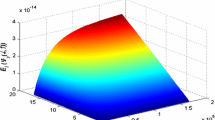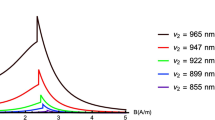Abstract
We consider a model for describing a QED system consisting of a photon beam interacting with quantized charged spinless particles. We restrict ourselves by a photon beam that consists of photons with two different momenta moving in the same direction. Photons with each moment may have two possible linear polarizations. The exact solutions correspond to two independent subsystems, one of which corresponds to the electron medium and another one is described by vectors in the photon Hilbert subspace and is representing a set of some quasi-photons that do not interact with each other. In addition, we find exact solution of the model that correspond to the same system placed in a constant magnetic field. As an example, of possible applications, we use the solutions of the model for calculating entanglement of the photon beam by quantized electron medium and by a constant magnetic field. Thus, we calculate the entanglement measures (the information and the Schmidt ones) of the photon beam as functions of the applied magnetic field and parameters of the electron medium.



Similar content being viewed by others
Data availability
This manuscript has associated data in a data repository. [Authors’ comment: All data included in this manuscript are available upon request by contacting the corresponding author.]
Notes
Of course, to be consistent, we should have used a notation like \(\left| \Psi _{{\upgamma }}(x)\right\rangle \) for the vector. However, here and in what follows, we denote this vector as \(\varphi _{{\upgamma }}(x)\), to simplify notations.
Recall that an operator \({\hat{G}}\) is called an integral of motion if its mean value
$$\begin{aligned} \left( \varphi ,{\hat{G}}\varphi \right) =\int \varphi ^{*}\left( x\right) \left( i\overleftrightarrow {\partial _{0}}-2eA_{0}\right) {\hat{G}} \varphi \left( x\right) d\mathbf {r}\,,\ \overleftrightarrow {\partial _{0}}= \overrightarrow{\partial _{0}}-\overleftarrow{\partial _{0}}\,, \end{aligned}$$calculated using any wave function \(\varphi \) satisfying the Klein–Gordon equation does not depend on time. For the operator \({\hat{G}}\) to be an integral of motion, it is sufficient that it commutes with the Klein–Gordon operator \({\hat{P}}_{\mu }{\hat{P}}^{\mu }-m^{2}\). If the operator \({\hat{G}}\) is an integral of motion, one can impose the condition that, apart from satisfying the Klein–Gordon equation, the wave function should be an eigenfunction of \({\hat{G}}\).
References
F. Bloch, A. Nordsieck, Phys. Rev. 52, 54 (1937)
N.N. Bogoliubov, D.V. Shirkov, Introduction to the Theories to the Quantized Fields (John Wiley & Sons, New York, 1980)
S. Albeverio, F. Gesztesy, R. Hoegh-Krohn, H. Holden, Solvable Models in Quantum Mechanics (Springer, Berlin Heidelberg, 1988)
V.G. Bagrov, D.M. Gitman, Exact Solutions of Relativistic Wave Equations (Springer, Dordrecht, 1990)
E.S. Fradkin, D.M. Gitman, Sh.M. Shvartsman, Quantum Electrodynam6ics with Unstable Vacuum (Springer-Verlag, Berlin, 1991)
S.P. Gavrilov, D.M. Gitman, Sov. Phys. J. 23, 491 (1980)
S. Schweber, An Introduction to Relativistic Quantum Field Theory (Harper & Row, New York, 1961)
I.A. Malkin, V.I. Man’ko, Zh. Eksp. Teor. Fiz. 55, 1014 (1968)
J.S. Bell, Speakable and unspeakable in quantum mechanics (Cambridge Univ. Press, New York, 1987)
J. Preskill, Course Information for Physics 219/Computer Science 219, Quantum Computation (Formerly Physics 229), http://theory.caltech.edu/~preskill/ph219/index.html#lecture
M.A. Nielsen, I.L. Chuang, Quantum Computation and Quantum Information (Cambridge University Press, Cambridge, 2000)
R. Alicki, M. Fannes, Quantum Dynamical Systems (Oxford University Press, New York, 2001)
I.S. Oliveira et al., NMB Quantum Information Processing (Elsevier, Amsterdam, 2007)
S. Barz, I. Kassal, M. Ringbauer, Y.O. Lipp, B. Dakic, A. Aspuru-Guzik, P. Walther, Nat. Sci. Rep. 4, 6115 (2014)
T. Nishioka, Rev. Modern Phys. 90(3), 035007 (2018)
E. Witten, Rev. Modern Phys. 90(4), 045003 (2018)
D. Campo, R. Parentani, Phys. Rev. D 72, 045015 (2005)
S.-Y. Lin, C.-H. Chou, B.L. Hu, Phys. Rev. D 81, 084018 (2010)
J. Adamek, X. Busch, R. Parentani, Phys. Rev. D 87, 124039 (2013)
X. Busch, R. Parentani, Phys. Rev. D 88, 045023 (2013)
D.E. Bruschi, N. Friis, I. Fuentes, S. Weinfurtner, New J. Phys. 15, 113016 (2013)
S. Finazzi, I. Carusotto, Phys. Rev. A 90(3), 033607 (2014)
S.P. Gavrilov, D.M. Gitman, A.A. Shishmarev, Phys. Rev. A 91, 052106 (2015)
A.D. Levin, D.M. Gitman, R.A. Castro, Eur. Phys. J. C 74(9), 1 (2014)
V.G. Bagrov, D.M. Gitman, A.D. Levin, M.S. Meireles, Intern. J. Quantum Inf. 15(1), 1750006 (2017)
D.M. Gitman, A.D. Levin, M.S. Meireles, A.A. Shishmarev, R.A. Castro, Int. J. Mod. Phys. A 33(21), 1850128 (2018)
A.I. Smirnov, Izv. Vyssh. Ucheb. Zaved. Fiz. 9, 132 (1974)
C.H. Bennett, H.J. Bernstein, S. Popescu, B. Schumacher, Phys. Rev. A 53, 2046 (1996)
W.K. Wootters, Phys. Rev. Lett. 80, 2245 (1998)
A. Peres, Phys. Rev. Lett. 77, 1413 (1996)
M. Horodecki, P. Horodecki, R. Horodecki, Phys. Lett. A 223, 1 (1996)
K. Życzkowski, P. Horodecki, A. Sanpera, M. Lewenstein, Phys. Rev. A 58, 883 (1998)
G. Vidal, R.F. Werner, Phys. Rev. A 65, 032314 (2002)
V. Vedral, M.B. Plenio, K. Jacobs, P.L. Knight, Phys. Rev. A 56, 4452 (1997)
O. Rudolph, Phys. Rev. A 67, 032312 (2003)
J. Lee, M.S. Kim, Časlav Bruker. Phys. Rev. Lett. 91, 087902 (2003)
J. Eisert, H.J. Briegel, Phys. Rev. A 64, 022306 (2001)
Funding
The work is supported by Russian Science Foundation, Grant No. 19-12-00042, https://rscf.ru/en/project/19-12-00042/.
Author information
Authors and Affiliations
Corresponding author
Ethics declarations
Conflict of interest
The authors have no relevant financial or non-financial interests to disclose.
Appendix A: Entanglement in two-qubit systems
Appendix A: Entanglement in two-qubit systems
We recall that a qubit is a two-level quantum-mechanical system with the Hilbert space \({\mathcal {H}}={\mathbb {C}}^{2}\). Vectors in the space \({\mathcal {H}}\) are two columns \(\left| \psi \right\rangle =(\psi _{1},\psi _{2})^{T}\). The scalar product reads: \(\langle \psi ^{\prime }\left| \psi \right\rangle =\psi _{1}^{\prime *}\psi _{1}+\psi _{2}^{\prime *}\psi _{2}\). An orthogonal basis \(\left| a\right\rangle \), \(a=0\), 1 in \({\mathcal {H}}\) can be chosen as: \(\left| 0\right\rangle =(1,0)^{T}\), \(\left| 1\right\rangle =(0,1)^{T}\), \(\langle a\left| a^{\prime }\right\rangle =\delta _{aa^{\prime }}\), \(\sum _{a=0,1}\left| a\right\rangle \langle a\mid \ = I\), where I is \(2\times 2\) unit matrix.
Examples include the spin of the electron in which the two levels can be taken as spin up and spin down; or the polarization of a single photon in which the two states can be taken to be the vertical polarization and the horizontal polarization.
Let us consider a system, composed of two qubit subsystems A and B with the Hilbert space \({\mathcal {H}}_{AB}={\mathcal {H}}_{A}\otimes {\mathcal {H}}_{B}\) where \({\mathcal {H}}_{A}={\mathbb {C}}^{2}\ \)and \({\mathcal {H}}_{B}={\mathbb {C}}^{2}\). The composite system is a four level and is also called the two-qubit system. If \(\left| a\right\rangle _{A}\) and \(\left| b\right\rangle _{B}\), a, \(b=0\), 1, are orthonormal bases in the spaces \({\mathcal {H}}_{A}\) and \({\mathcal {H}}_{B}\), respectively, then \(\left| \alpha b\right\rangle =\left| a\right\rangle \otimes \left| b\right\rangle \) is a complete and orthonormalized bases in \({\mathcal {H}}_{AB}\), which is called computational bases,
where \({\mathbf {I}}\) is \(4\times 4\) unit matrix. The vectors of the computational bases are eigenstates of the operator \(\sigma _{z}\otimes \sigma _{z}=\mathrm {diag}(1,-1,-1,1)\), namely \(\left[ \sigma _{z}\otimes \sigma _{z}\right] \left| aa^{\prime }\right\rangle = (-1)^{(a+a^{\prime })}\left| aa^{\prime }\right\rangle \). The basis is often denoted as \(\left| \Theta \right\rangle _{s} \),\(\ s=1,2,3,4\),
A pure state \(\left| \Psi \right\rangle _{AB}\in {\mathcal {H}}_{AB}\) is called separable if and only it can be represented as \(\left| \Psi \right\rangle _{AB}=\left| \Psi \right\rangle _{A}\otimes \left| \Psi \right\rangle _{B}\), \(\left| \Psi \right\rangle _{A}\in {\mathcal {H}}_{A}\),\(\ \left| \Psi \right\rangle _{B}\in {\mathcal {H}}_{B}\). Respectively, a state \(\left| \Psi \right\rangle _{AB}\) is entangled if it is not separable.
A measure of the entanglement is a real positive number \(E(\left| \Psi \right\rangle _{AB})\in {\mathbb {R}}_{+}\) which is assigned to each state \(\left| \Psi \right\rangle _{AB}\). The measure of entanglement is zero for separable states and assumes its maximum 1 for maximally entangled states.
An entanglement measure \(E(\left| \Psi \right\rangle _{AB})\) of a state \(\left| \Psi \right\rangle _{AB}\) of a two-qubit system was proposed by Bennett in Ref. [28]. It readsFootnote 3:
where \(S({\hat{\rho }}_{A})\) is von Neumann entropy of a statistical operator \({\hat{\rho }}_{A}\) of the subsystem A, whereas \(S({\hat{\rho }}_{B})\) is von Neumann entropy of the statistical operator \({\hat{\rho }}_{B}\) of the subsystem B (one can see that \(S(\rho _{A})=S(\rho _{B})\)). For a pure state \(\left| \Psi \right\rangle _{AB}\), we have:
In the case of a pure state, its reduced statistical operators have nonzero quantum entropy, whereas the entropy of the initial pure state is always zero. By definition, a pure state of a two-qubit system is maximally entangled if its reduced statistical operators are proportional to the identity operators.
Let us decompose the state \(\left| \Psi \right\rangle _{AB}\) and the operator \({\hat{\rho }}_{AB}\) in the computational bases,
Then, with account taken of the relations
where states \(\left| a\right\rangle \) basis vectors in the Hilbert space \({\mathcal {H}}_{A}\), we obtain:
Calculating the entanglement measure, we can use eigenvalues of the matrix \({\hat{\rho }}_{A}\),
Thus, we obtain
and by convention we adopt that \(0\log _{2}0\equiv 0\) (see, e.g., Ref. [11]).
It is also known that for a pure two-qubit state one can recognize entanglement by evaluating the so-called Schmidt measure \(E_{\mathrm {S}}(\Psi )\), which is the trace of the squared reduced density operators,
The Schmidt measure can be considered as an alternative to the information entanglement measure.
Rights and permissions
Springer Nature or its licensor holds exclusive rights to this article under a publishing agreement with the author(s) or other rightsholder(s); author self-archiving of the accepted manuscript version of this article is solely governed by the terms of such publishing agreement and applicable law.
About this article
Cite this article
Breev, A.I., Gitman, D.M. Light beam interacting with electron medium: exact solutions of the model and their possible applications to photon entanglement problem. Eur. Phys. J. Plus 137, 968 (2022). https://doi.org/10.1140/epjp/s13360-022-03206-4
Received:
Accepted:
Published:
DOI: https://doi.org/10.1140/epjp/s13360-022-03206-4




